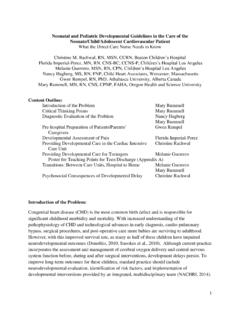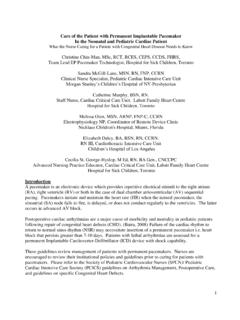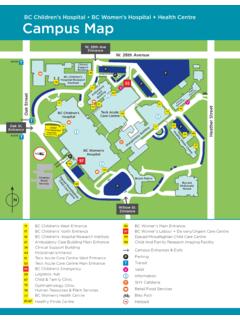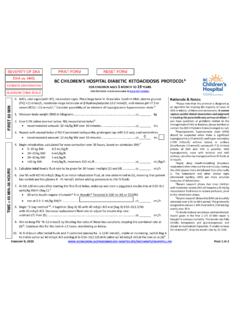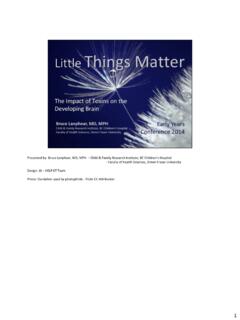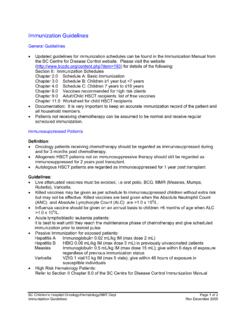Transcription of Prevention of Device Associated Infections in the Neonatal ...
1 Prevention of Device Associated Infections in the Neonatal and Pediatric Cardiac Patient What every nurse needs to know. Debra Forbes Morrow, BSN, RN, CCRN, Boston children 's hospital Justine Mize, MSN, RN, CCRN, CPN, children 's National Health System Annierose D. Abogadie BSN, RN, CCRN, RN-BC, children 's National Health System Nida Sulit-Oriza, BSN, RN, children 's hospital Los Angeles Amy Donnellan, MSN, RN, CPNP-AC,,Cincinnati children 's hospital Medical Center Sandra Staveski, PhD, RN, CPNP-AC, Cincinnati children 's hospital Medical Center Introduction.
2 children with heart disease in the Pediatric Cardiac Intensive Care Unit (PCICU) are at risk for hospital -acquired Infections given their complex physiologies and requirement for complex invasive procedures and supportive modalities. These guidelines will review important considerations for infection Prevention specifically for ventilator Associated pneumonia (VAP), catheter- Associated urinary tract Infections (CAUTI), and central line Associated bloodstream Infections (CLABSI). We will also make recommendations for antibiotic stewardship.
3 Introduction of the Problem: Central venous lines, ventilators, and urinary catheters are routinely used for assessment and support of patients following cardiac surgery. However, these devices are responsible for up to 80% of hospital acquired Infections . Device Associated Infections (VAP, CAUTI, and CLABSI) are linked with increased morbidity, mortality, length of stay, and overall hospital costs in all patients regardless of age or diagnosis. As of 2012, CAUTI. was the leading Device Associated infection in pediatric cardiac patients followed by CLABSI, and then VAP.
4 CAUTI are also a significant cause of secondary bloodstream infection. In 2009, the Centers of Medicare and Medicaid began to withhold reimbursement to hospitals, for the care Associated with treating hospital acquired Infections . Multiple studies have shown that utilizing bundles of care aimed at preventing these Infections are more effective than singular modalities of care. A. bundle is defined as a group of interventions that improve patient outcomes when followed by every member of the healthcare team Critical Thinking Points for all Infection Prevention Bundles: Hand hygiene is the basis of all infection Prevention initiatives.
5 Perform hand hygiene: o Before and after contact with a patient or the patient's environment o Before and after manipulating an invasive Device 1. o Before and after wearing gloves o Wash hands with soap and water when visibly soiled and/or caring for a patient with C-difficle, Norovirus, or Bacillus anthracis o Educate healthcare personnel regarding indications for central venous line, endotracheal tube, and urinary catheter use; the proper procedures for the insertion and maintenance of these devices; and appropriate infection control measures to prevent Device Associated Infections Periodically assess knowledge of and adherence to guidelines for all personnel involved in the insertion and maintenance of central venous lines, endotracheal tubes.
6 And urinary catheters Create insertion checklists which empower staff to provide clinical reminders/feedback at the point of care if any of the sterile insertion practices are missed Develop a system of alerts or reminders to identify all patients with indwelling devices Assess the need for the continued use of indwelling devices on a daily basis and formulate a plan for their early removal if they cannot be discontinued Implement infection surveillance programs that include feedback of unit-specific infection rates, hand hygiene compliance, and indwelling Device management Educate parents on the appropriate indications for and care of indwelling devices, the importance of hand hygiene, and encourage their participation in preventing healthcare Associated Infections Prevention of Ventilator Associated Pneumonia Critical Thinking Points.
7 The bundle to prevent ventilator Associated pneumonia has four main components Elevation of Head of Bed 30 degrees or maintain the reverse Trendelenburg position for infants in isolettes or warmers. Elevating the HOB prevents aspiration of stomach contents, and prevents pooling of oral secretions in the posterior oro- pharynx Institute a comprehensive oral care program consisting of oral hygiene at least every 12 hours and oral care as needed: o Oral Hygiene: use a soft toothbrush with toothpaste, and sterile water to remove plaque from teeth, gums, and tongue.
8 Use a gauze and sterile water to clean the gums and tongue of infants without teeth. Mechanical removal of plaque helps to prevent the colonization of microorganism in the mouth which can contaminate the lower airway. o Oral care: maintain moist lips and oral cavity, and the aspirate secretions from the posterior oro-pharynx prior to position change and as needed 2. Drain ventilator condensate away from patient to prevent aspiration of contaminated fluid Assess the need for ventilation every day. Daily sedation vacations are recommended as soon as the patient is stable.
9 Institute ventilator weaning and extubation as soon as possible Modification of Risk Factors: Suctioning: Suctioning of the lower airway is a sterile procedure. Suction only as indicated for increased secretions or changes in patient status such as decreased tidal volumes or oxygen saturations, or increased work of breathing or peak inspiratory pressures. Instillation of physiologic saline is not recommended on a routine basis. Institute early enteral feeds: Enteral feeding supports the immune system and supports normal gastric flora, preventing the overgrowth of abnormal flora.
10 Consider naso-jejunal feeds in patients at risk for reflux, and monitor feeding residuals to assess gastric motility and prevent gastric over-distention. Intubation/ re-intubation: Assure equipment used for intubation remains as sterile as possible, utilize a sterile towel for intubation equipment. Utilize other methods of respiratory support, such as nasal CPAP or high flow nasal cannula before intubation or re-intubation Equipment maintenance: Dispose of yankaur suction catheters every 24 hours at a minimum.

